
Every nonprofit wants loyal donors that keep coming back to show their support. But how do you attract and keep them? These ideal donors don’t come about by accident. You need a strong approach to donor engagement to attract, convert, and retain your donors.
In this guide, we’re taking a closer look at the donor engagement strategies, best practice tips, and steps you need to create a successful strategy plan.
What is donor engagement?
Donor engagement covers all the different ways you interact with your supporters as a nonprofit organization. This can include sending newsletters, thank you notes, donor receipts, phone calls, and more.
At the heart of donor engagement is building a strong, lasting relationship—the kind that will create a loyal donor for years to come. With those loyal donors comes more donations, reliable support, and the opportunity to attract major donors and sponsors for events and projects.
The donor engagement cycle
Donor engagement is happening all the time, but it’s helpful to look at it through the lens of a donor cycle. The strategies you use at each stage are different, so you need to adjust your activities based on your relationship with each donor.
The four main stages in the donor cycle are:
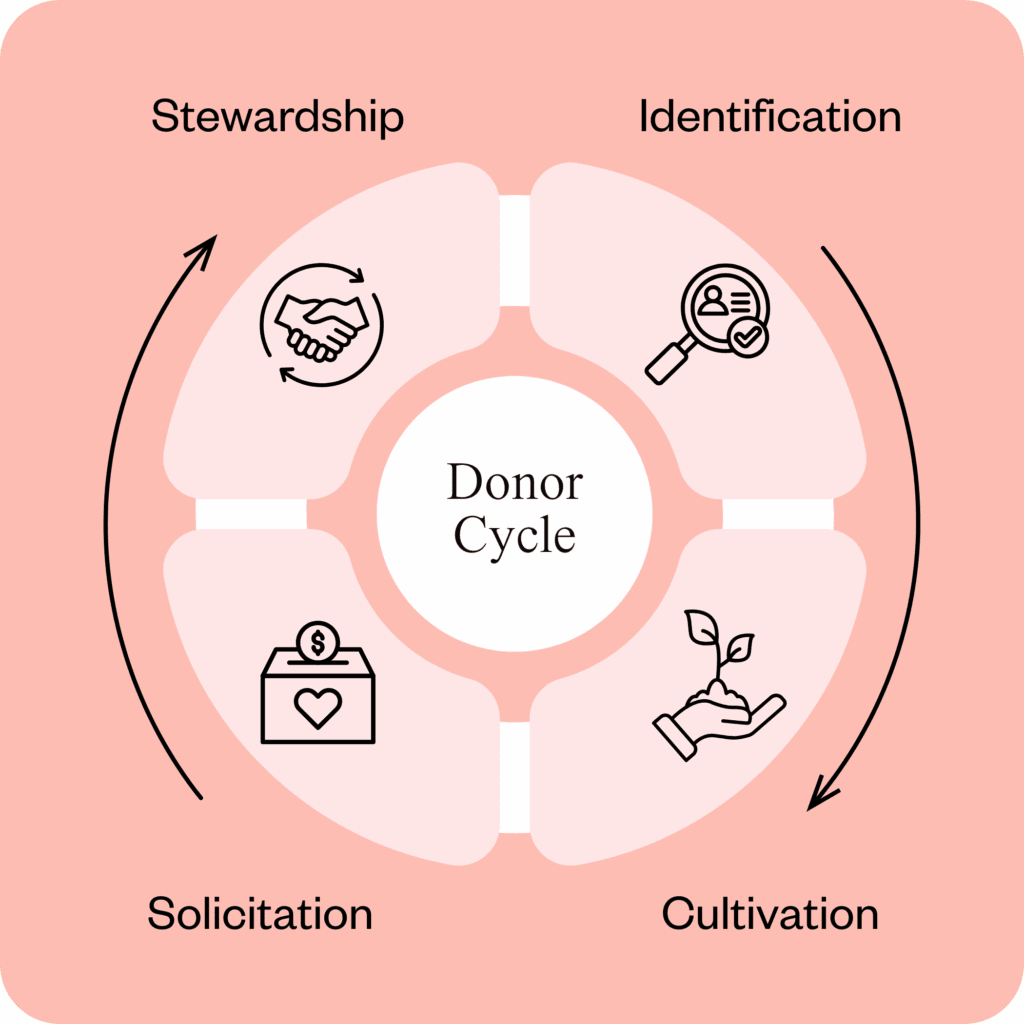
- Identification: Finding prospective donors that are most likely to be inclined and able to support your organization.
- Cultivation: Starting and building donor relationships, so they feel close to your cause.
- Solicitation: Asking your would-be or existing donors for their financial support, in a way that’s likely to be successful.
- Stewardship: Taking care of the ongoing relationship with your donors, so they feel appreciated.
While your actions at every stage of the cycle are different, the end goal is the same: to create happy, loyal supporters that give to your cause repeatedly.
Why you need to measure donor engagement
If you don’t track donor engagement, you have no idea whether your current strategies are working or not. But when you regularly monitor donor engagement signals, you can quickly identify opportunities to go all-in on what works and rework what doesn’t.
Measuring donor engagement signals allows you to:
- Evaluate your existing strategies: Identify strengths, weaknesses, and opportunities to enhance what you already do.
- Build relevant donor segments: Organize your data effectively, so you can send more tailored donor communications.
- Identify major gift prospects: Understand who is most likely to become a major donor, so you can start building a relationship with them earlier.
- Work proactively to maintain donor relationships: Halt donor attrition and look for opportunities to win back donors before they become disengaged.
- Deliver personalized communications: Match what you send to donor activity, engagement levels, and interests.
- Create more meaningful experiences: Use data to decide which events to invite donors to, how to encourage them to give, and more.
- Find future volunteers: Identify people that are most likely to become advocates or volunteers.
- Build a stronger brand: Let everyone know how supportive, responsive, and welcoming your organization is through tailored, proactive communications.
While it might take slightly longer to collect data and measure donor engagement, it’s well worth it for the benefits you gain in terms of donor loyalty.
7 effective donor engagement strategies
Your donor engagement should be always-on, but how do you achieve that? Add some of these tried-and-true donor engagement tactics to your strategy for the year ahead.
1. Say thank you in a meaningful way
Most organizations send a thank you message on receipt of a donation, but not all of them make the most of this easy opportunity to convert passive supporters into long-time donors.
Instead of a generic thank you note, make it feel like it was written for that specific donor from your organization. Here’s how to do this:
- Insert the donor’s name
- Use words and language that feels like your nonprofit’s brand and style
- Add the donation amount or the specific support given
- Mention how their donation will help your cause
- Invite the donor to join your mailing list or community
- Sign off your thank you message from a named individual
Gratitude should go beyond donation thank you notes, too. Look for other opportunities to say thank you to donors—like when they share your campaign on social media, introduce a potential sponsor, or help out a community member.
Be sure to tailor your gratitude to every donor’s preferences, if you can. If you know they’d love a big public thank you, then give them a shout out on your social media. For more private individuals, a handwritten thank-you letter is a nice touch.
The art of thank-you letters
Learn best practices for expressing gratitude that enhance donor engagement and retention, and inspire future giving.
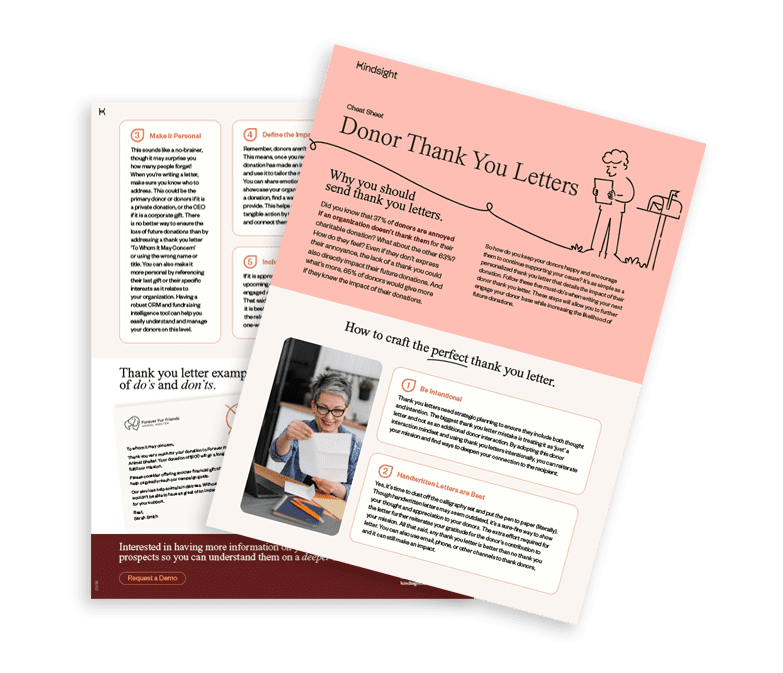
2. Create personalized experiences
Donors want to feel like they’re more than a name or number on your list. Use personalization to create one-of-a-kind experiences that they can’t get anywhere else.
Engaging with donors in a more individual way is an ideal way to keep their interest—especially in the donor cultivation and stewardship stages of the cycle.
Examples of personalized experiences include:
- Card or message on their birthday or giving anniversary
- Behind-the-scenes tours—both in-person and virtual
- First-look at new merch
- Small focus groups and feedback sessions
- Recommendations based on their interests and hobbies
- Competitions to design or shape merch, projects, or campaigns
Some of these ideas involve more resources than others, but even with a limited budget you can still pull off some creative activities and events that your donors will love.
3. Invite donors to exclusive events
Another way to show your gratitude to donors is to invite them to events. Whether it’s a gala night or a golf team fundraiser, giving your donors early or exclusive access to event tickets makes them feel special.
Some of our community’s favorite event ideas include:
- Donor appreciation event
- Gala night with auction
- New building tour
- Family fun day
- Sports fundraising event
- Coffee and cake
- Fireside chat with board members
Creating a meaningful donor engagement experience goes beyond the tickets. Look for other ways you can make donors feel appreciated—like goody bags, discounted tickets, complimentary refreshments, or a donor wall at the event.
4. Share impact stories
Donors don’t always hear about the difference that their contributions make. Let your supporters know that their donation matters and share updates on what you’ve been able to achieve with their support.
Give donors updates that include:
- How many people you’ve helped so far
- Thank you messages from recipients
- What percentage of the project is now funded
- Your next steps
Let your impact stories come to life through photos, videos, podcasts, and the voices of the people and communities you’ve helped. Hearing how a donation has impacted someone first hand is extremely powerful.
5. Create a community
Having what feels like a 1:1 relationship with your favorite nonprofit is fun, but what can make it even better is when you can also tap into a welcoming community. Give your supporters somewhere to hang out with peers by creating your own community.
Invite your donors to use the community to:
- Say hello to new donors and other supporters
- Make friends and connections
- Learn more about your organization and work
- Donate to your current campaign
- Watch videos, webinars, and livestreams
- Take part in exclusive chats, Q&As, and events
- Sign up for your newsletter
- Join as a volunteer
- Invite friends to join the community
An online community requires ongoing support and moderation, but this can be a great role to hand off to loyal volunteers. With clear guidance and a helpful team of mods, your online community can thrive.
6. Get your whole team involved
It’s wise to have one or only a handful of people actively working on your donor engagement strategies. But in some moments, getting other people involved can be a great decision.
When your donors receive a call, message, or letter from a named person at your organization they’re more likely to feel special. Use this to your advantage, and find the right person to send the right communication.
Examples include:
- Phone call to major donors from a board member
- Thank you note to volunteers from your volunteering lead
- Message of appreciation from someone your donor has personally interacted with
- Welcome message to new donors from your founder or board members
- Thank you email from someone on your project team
Lots of organizations use their board members to fulfil this role, but by widening it out to include different people across your nonprofit you can create even more meaningful donor experiences.
7. Ask for donor feedback
Even with the best intentions, your donor engagement strategies might fail if you don’t consider feedback from your community. Be open to hearing feedback and give your donors lots of ways to send it.
Great channels for feedback include:
- Quarterly or annual feedback survey
- Monthly polls
- Anonymous suggestion box
- Feedback thread in your online community
- Post-event feedback surveys
Gather feedback, ideas, and suggestions and review them regularly. You might discover a hidden opportunity, or learn that the new strategy you introduced is your donors’ favorite one yet.
Donor engagement best practices
The donor engagement process involves more than just the strategies or tactics you use. It’s also about how you show up.
Create the right environment for success with these tips:
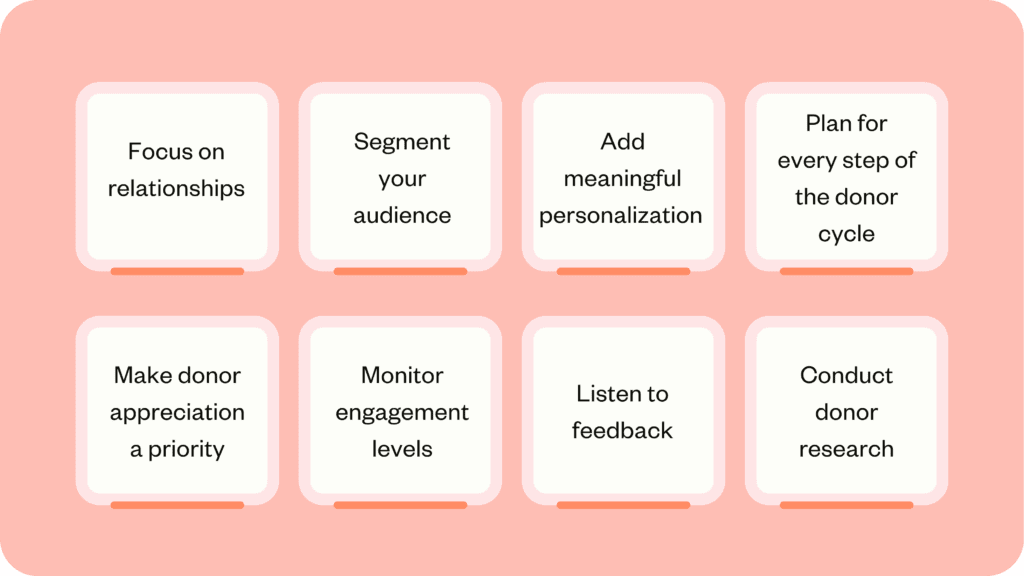
- Focus on relationships: Make your end goal to build trust with donors and increase donor retention, rather than hit a revenue figure.
- Segment your audience: Build donor segments based on engagement, interests, and donor history to send more tailored communications.
- Add personalization in a meaningful way: Go beyond using the donor’s first name and show how well you know them.
- Plan for every step of the donor cycle: Don’t spend all your resources on trying to solicit donations—make sure individual donor stewardship is always happening.
- Make donor appreciation a priority: Focus on gratitude and making your existing and new donors feel appreciated.
- Monitor engagement levels: Keep track of engagement levels by individuals and wider trends, so you can make smarter decisions.
- Listen to feedback: Shape your future engagement around what your donors ask for.
- Don’t forget to conduct donor research: Look for ways to enhance your donor records so you can create more personalized interactions.
If you apply these best practices and work on your donor engagement strategies, you’ll have a strong foundation in place.
How to build a donor engagement plan in 6 steps (+ template)
Once you’re familiar with donor engagement best practices and tactics, it’s time to bring everything together into one strategic plan.
Here’s how to build your donor engagement plan in 6 steps.
1. Set a goal
Before you write your plan, it’s helpful to have a goal in mind. Do you want to raise engagement levels by 25%? Convert more one time donors into recurring donors? Increase your donor retention rates by 50%?
Set a goal, and let it guide the rest of your strategy. Once you know whether success lies in additional revenue, recurring donations, or higher engagement levels, you can optimize your plan with this in mind.
2. Identify your resources
Figure out what your available resources are. This could include fundraising team members, a financial budget, marketing materials, volunteers, agreed sponsors, and more.
Next, decide whether your existing resources are sufficient or if you need to increase your headcount or budget. If you need more resources, get ready to prepare a solid business case so you’re more likely to get approval.
3. List donor engagement strategies
Within your donor engagement strategy or plan you’ll have a list of activities and moments of engagement. Create a master list of all the tactics you want to use, so you can decide when to use them.
Once you have a list, map out where these activities apply within the donor cycle. Make sure you have a good spread of tactics and that you aren’t missing any chances to engage with donors.
4. Create a repeatable process
Use your strategies to create simple, repeatable workflows that you can apply to both new and existing donors. Decide when to send a welcome email, which touchpoints you’ll use to engage and when, and how often you’ll communicate with donors.
Make it as easy as possible to repeat the process every time. Create a checklist that team members can use, or embed the workflow within your project or task management software.
5. Assign roles and resources
For your plan to be a success it needs to be clear who takes care of what. Assign different team members to specific roles, so there’s no confusion.
Who gets assigned to which task will depend on the size of your team. In a small team, one or two people might take care of the majority of the work. In a larger team, you can assign individuals or a specific team to take care of tasks.
6. Finalize your donor engagement plan
Donor engagement touches every part of the donor lifecycle and is essential if you want to retain donors, so your plan will often require sign-off. If it does, make sure it’s user-friendly and ready for review.
Provide your board members or senior leadership team with a copy of your proposed plan, along with reasoning on why you’ve chosen the strategies you have. Answer questions, offer reassurance, and express how confident you are that your new plan will help drive donor engagement.
Donor engagement plan template
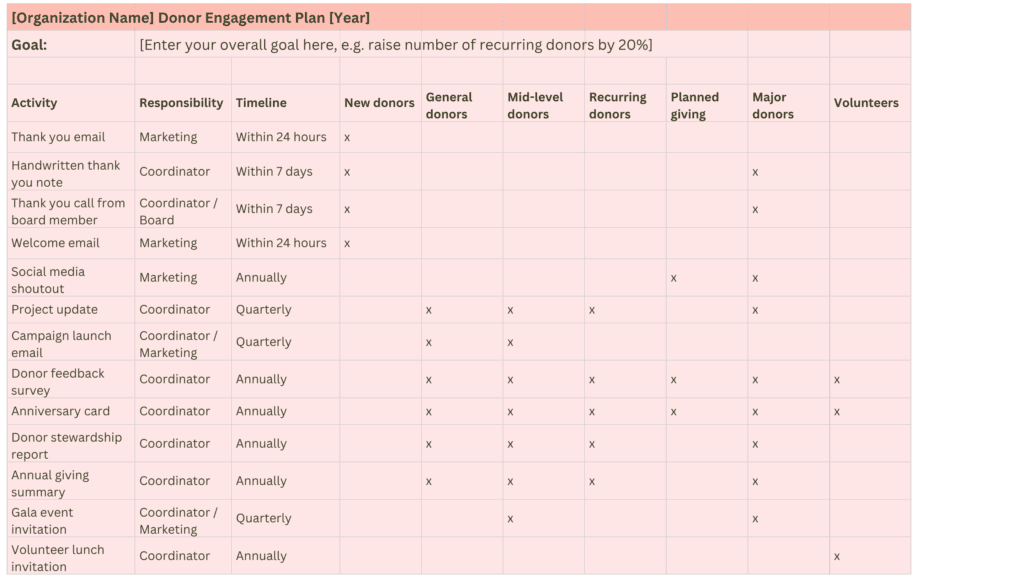
Link to sample spreadsheet here.
Enhance engagement right across the donor cycle
The right donor engagement strategy can take your good intentions and turn them into a reliable, effective way to attract and retain donors. Use these strategies and tips to create a donor engagement plan that allows you to appreciate your supporters at every stage of the cycle.
Want more consistent and committed long-term donors?
Our guide shows you the strategies and tactics you need to effectively move prospects through the donor cultivation cycle.
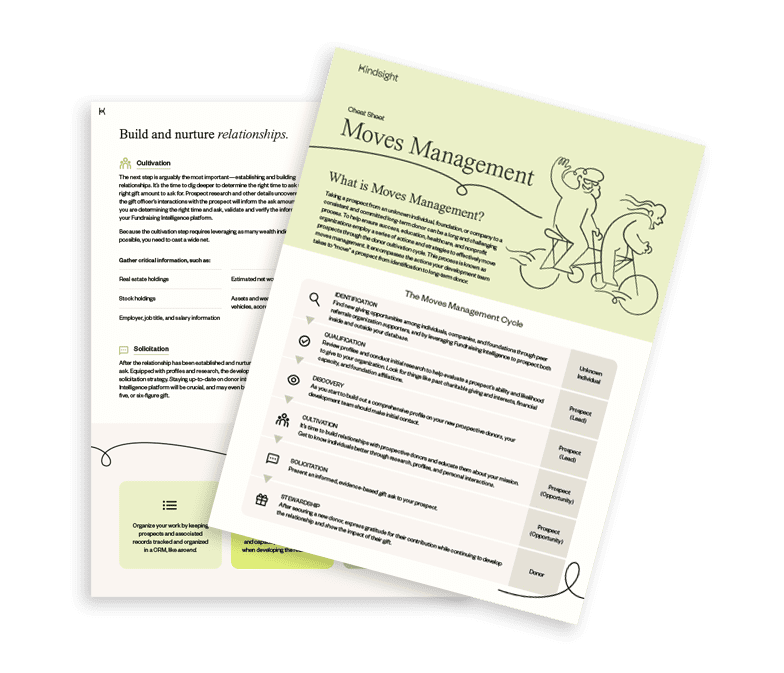
Be the first to read our resources.
The world is changing quickly—and our resources help you stay on top of it all. Sign up to get new insights, success stories, and more, sent right to your inbox.




